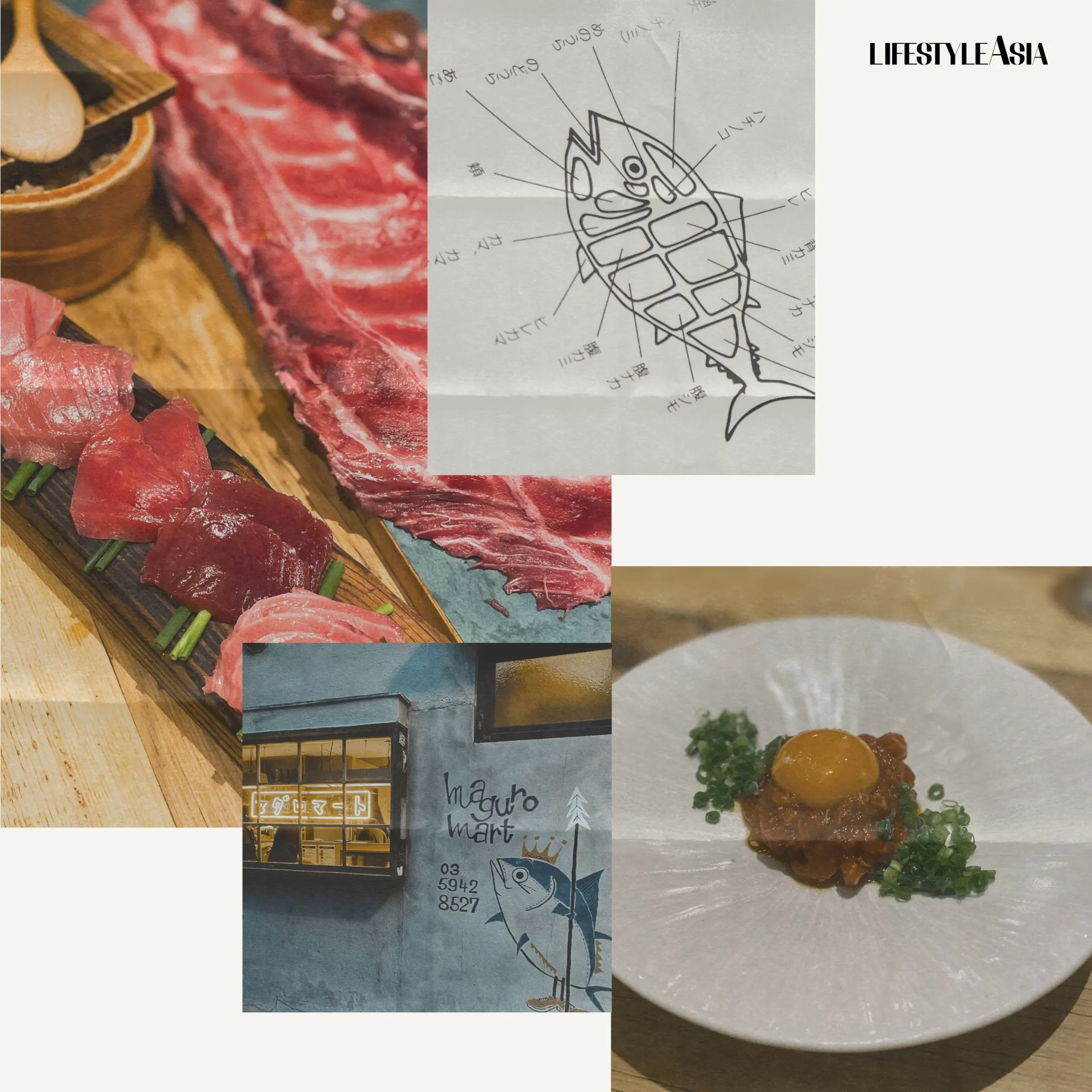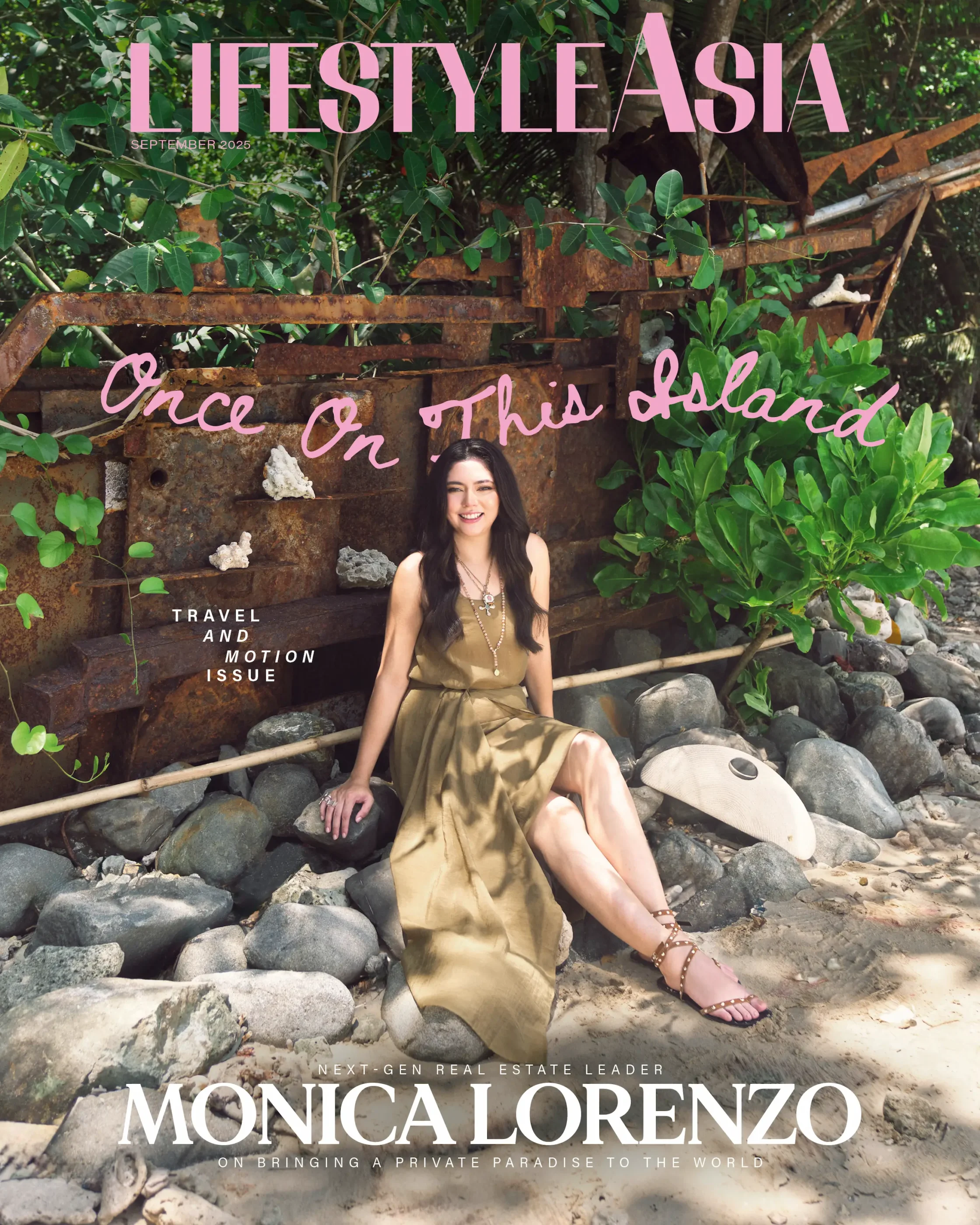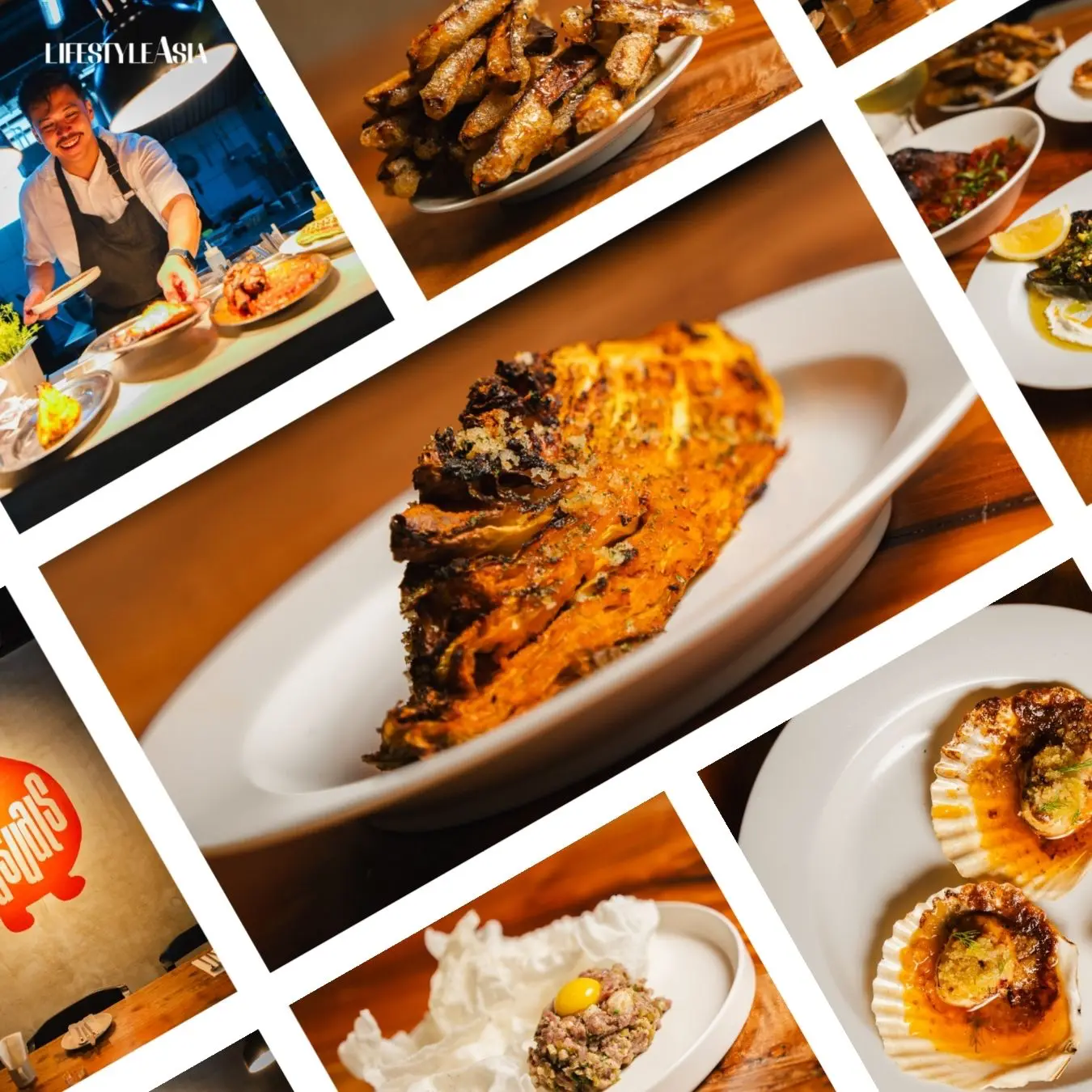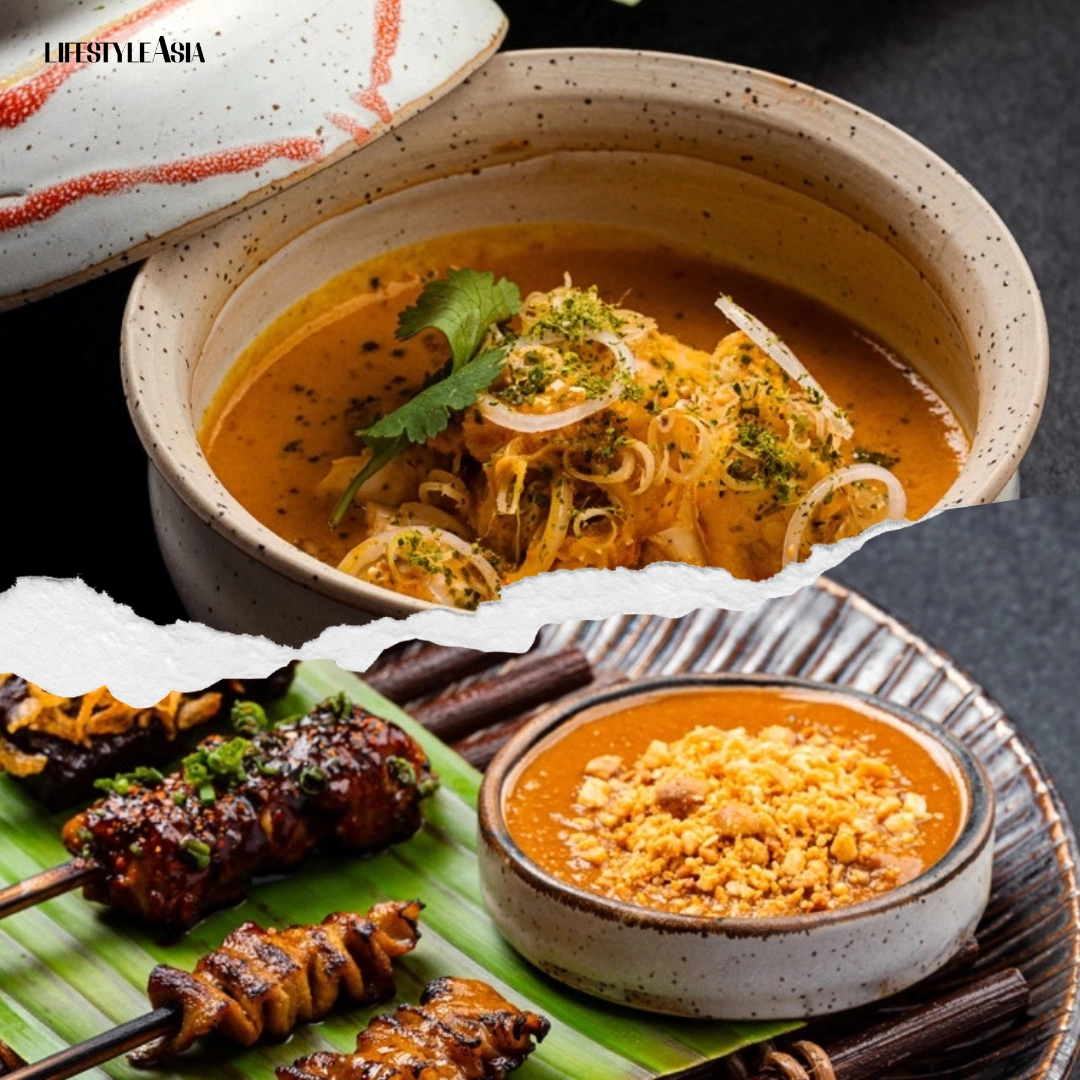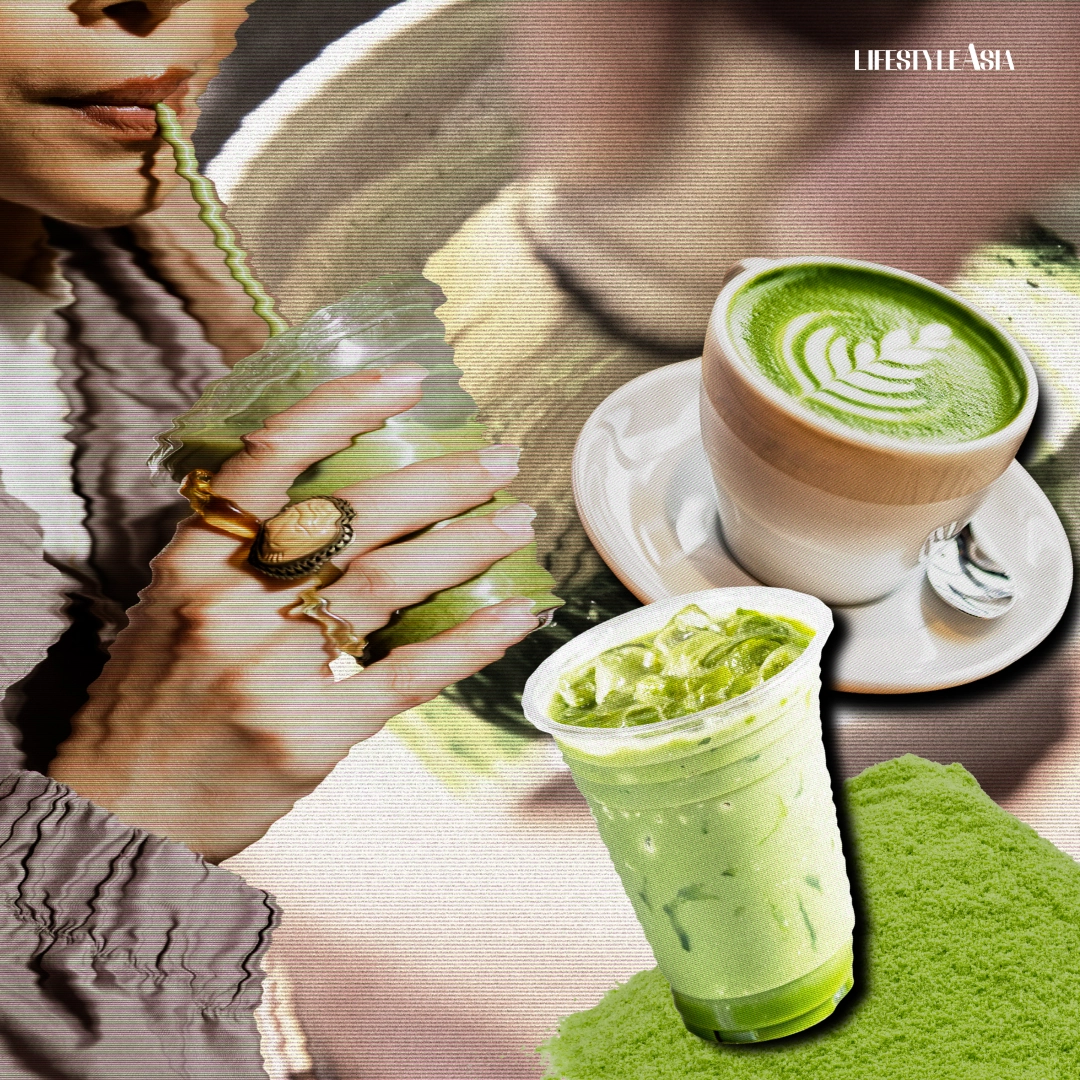Maguro Mart may be tucked away in the quiet, unassuming neighborhood of Nakano, Tokyo, but it offers a vibrant tasting menu built around bluefin tuna—delivering a modern dining experience that took our Japan trip to the next level.
The Japanese take great pride in their food culture, with chefs and cooks emphasizing the freshness of ingredients to bring out both flavor and technique. One of the shining stars of their cuisine is undoubtedly tuna, or maguro, which can be served cooked or, more traditionally, raw and incredibly fresh, sashimi-style. The Japanese people have been eating this fish for thousands of years—not just for cultural reasons, as it reflects the country’s deep connection to the sea, but also for economic reasons, with generations of fishermen building their livelihoods around it. Today, the country is the world’s largest consumer of tuna.
In every corner of Japan—especially in lively cities like Tokyo—you can find tuna dishes. Popular tourist destinations like the Tsukiji Market have fostered a strong tuna culture, with fishermen auctioning off their most premium catches as early as 530 AM. Local eateries serve their versions of maguro in a variety of ways: here, you can not only easily find beautifully prepared tuna sashimi with a gorgeous side of authentic and handmade wasabi, but also many restaurants that offer creative takes on the fish—deep-fried in panko breading, stewed for hours, or lightly seared as tataki. The options are endless.
While mainstream restaurants in tourist-heavy areas like Shibuya, Ginza, and Shinjuku often drive up prices of the popular fish, one small, laid-back eatery on the outskirts of Tokyo offers a vibrant tasting menu featuring an assortment of bluefin tuna cuts. This hidden gem is called Maguro Mart; nestled in the quiet neighborhood of Nakano, it invites curious diners to explore the beauty and flavors of the beloved protein.
READ ALSO: Fukui: The Most Interesting Japanese Region You’ve Probably Never Heard Of
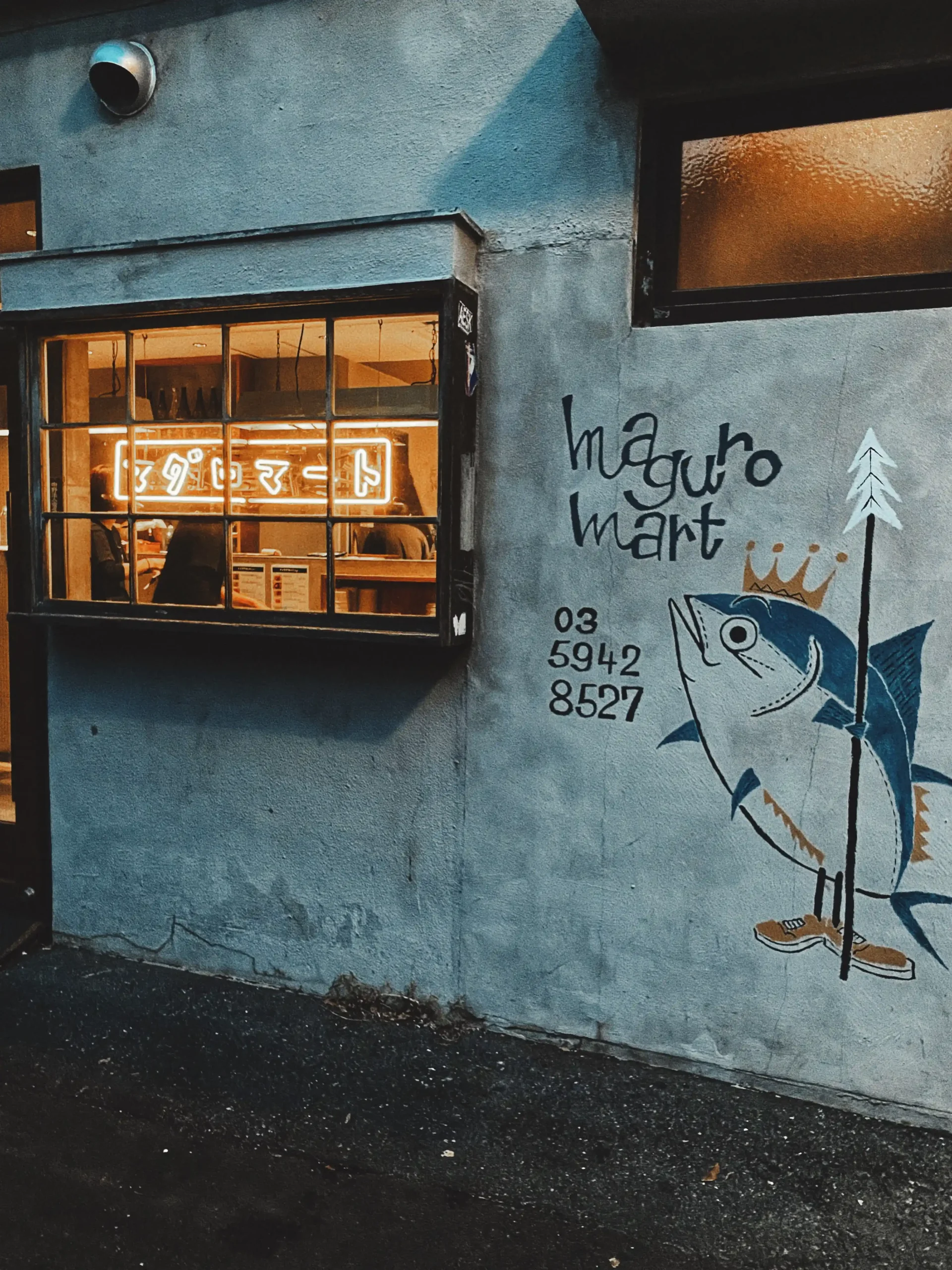
Maguro Mart Is Nakano’s Best Kept Secret
Nakano wasn’t the first place I expected to find such a hip restaurant, yet Maguro Mart has been thriving there since 2012, becoming the area’s best-kept culinary secret. It’s a bit out of the way—about 40 minutes by train from the upscale district of Ginza—but the travel time is definitely worth it. When I arrived, the area was bustling with locals, and there were hardly any tourists in sight. Narrow streets were lined with bars, restaurants, and small shops. At the edge of the charming neighborhood stood the restaurant, which had already drawn a line of diners waiting to be seated an hour before it opened at 5 PM. It came highly recommended, so my group and I made sure to book our table weeks in advance through their official website.
Upon arriving, we were greeted by a traditional two-story building, built in the same style as the other structures around the village. Adorning its aged white exterior was a large, whimsical illustration of a tuna fish holding a spear—surely ironic, but it immediately gave me a sense of how playful the dishes inside would be. The neon signage cast a soft yellow glow over the street, evoking not only a warm and inviting atmosphere but also a modern one. I quickly realized that this wasn’t your traditional izakaya.
Since we arrived early, we waited at the bar next door, which offered a good selection of sake; we were eager to kick-start our evening with a nice alcoholic beverage. But true to the wonderful and reliable punctuality of the Japanese people, our reservation was ready right on the dot. Upon entering the restaurant, we were escorted to our table, which was already set with menus explaining the different cuts of maguro, alongside charming little plates featuring the anatomy of the fish.
The space was surprisingly modern, with similar illustrations from the exterior decorating every corner of the restaurant’s walls. A large open kitchen, featured on both floors, invited my curiosity and imagination to speculate on the incredible meal to come.
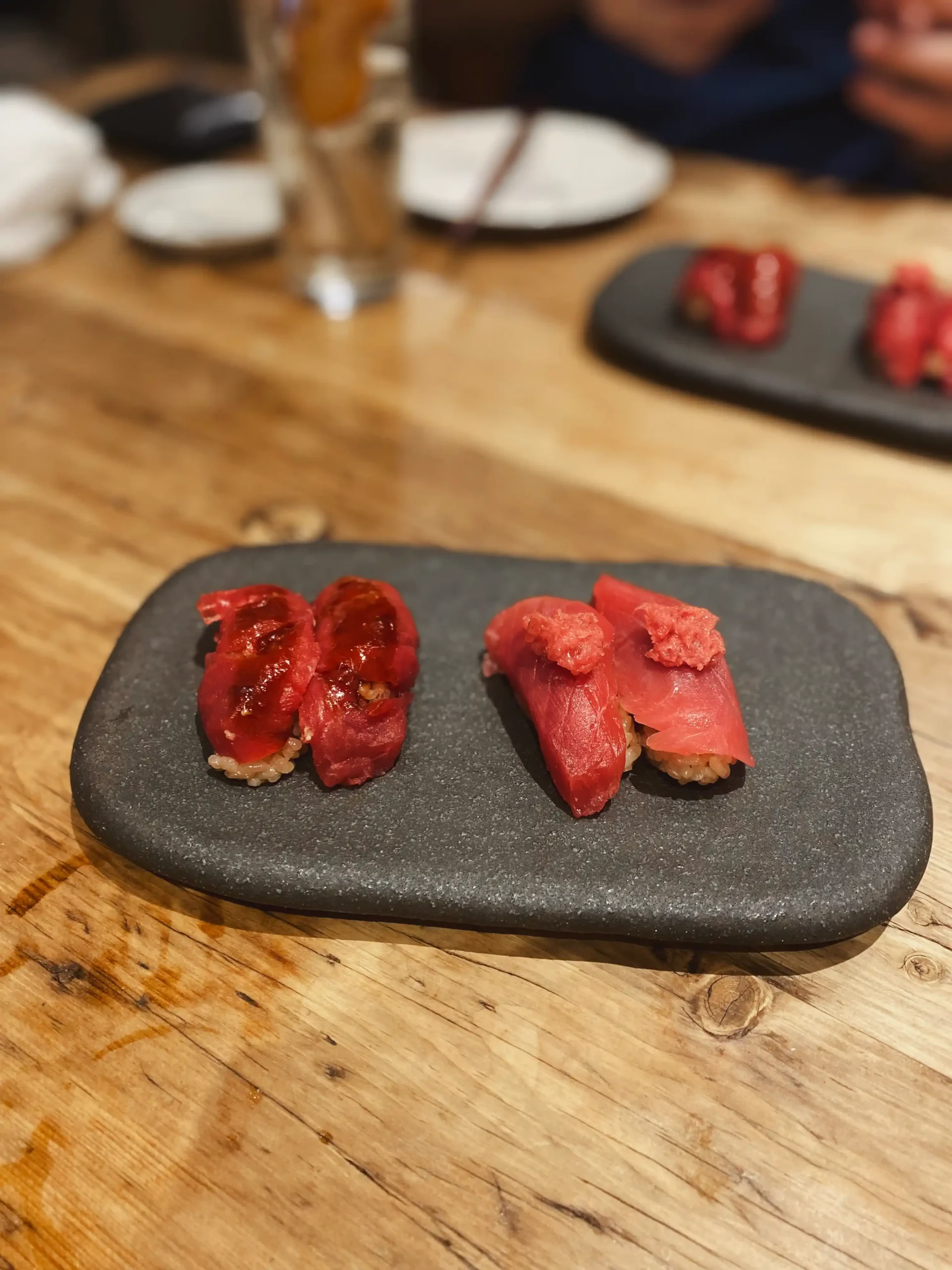
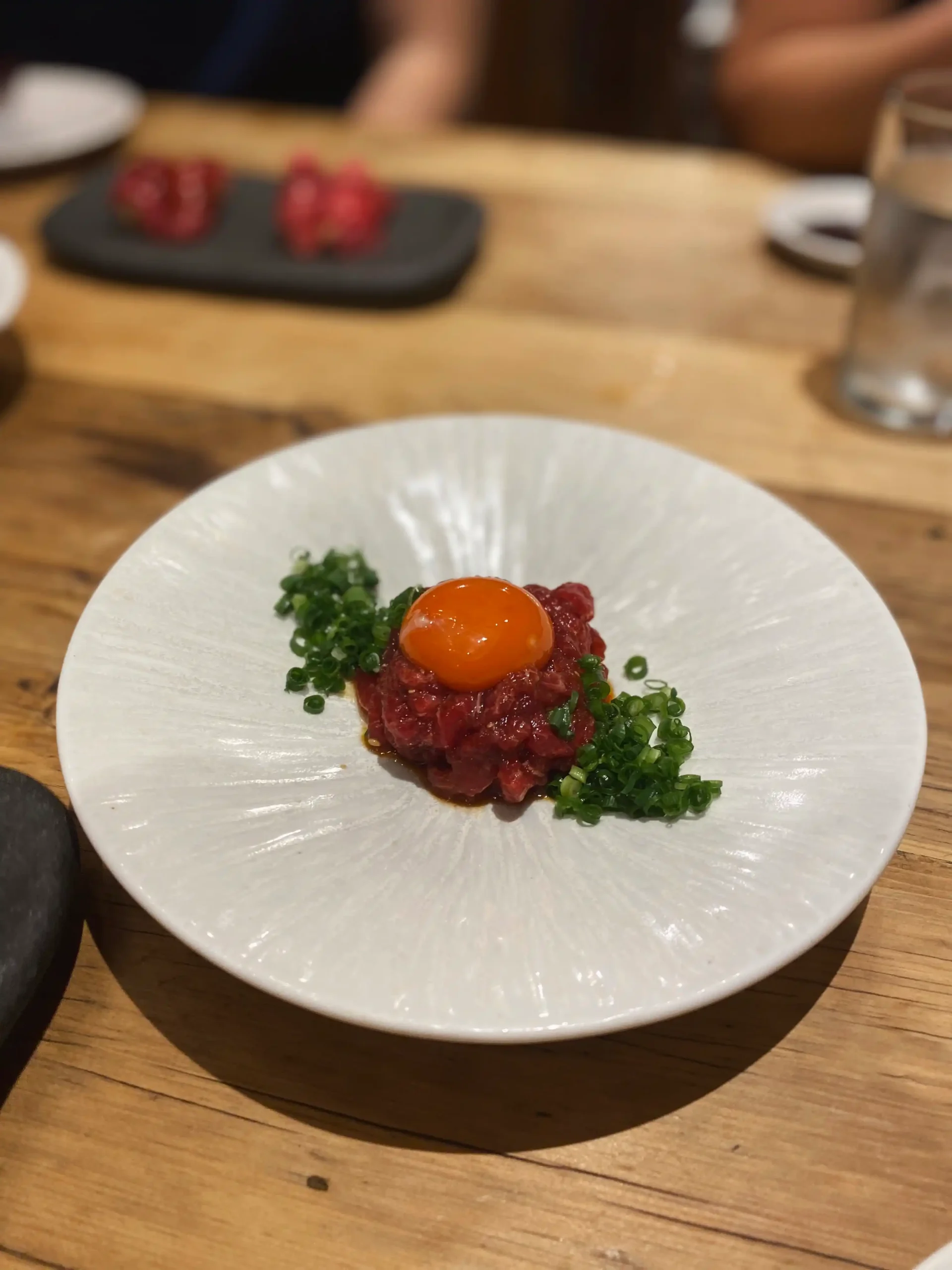
Starting the Maguro Party
Maguro Mart’s menu is limited in size, but built around the quality of rare tuna freshly sourced from Toyosu Market—the largest in Japan, known for its high-quality seafood. Each dish features one or more of five different types: rich and fatty bluefin tuna; the highly valued Southern bluefin; deep-water bigeye tuna; the more commonly used yellowfin; and the light, mild-tasting albacore. Patrons can choose between a seven-course or an eight-course menu. I went with eight courses, undaunted by the heavy day of eating I’d already had.
While waiting for the food to be served, we ordered drinks from the eatery’s extensive bar menu, which included various sake options, suggested highball pairings, draft beers, a handful of teas and juices, and a curated list of “Maguro Mart Recommended Cocktails.” The clear standout was their signature Whiskey Highball with Pickled Grilled Apple. The apple was marinated overnight and served whole inside the glass, giving the drink a sweet-and-sour kick that left my tastebuds fluttering.
When I was finally tipsy from my strong cocktail, the first course arrived. And just as I expected, it was raw tuna sushi to get the maguro party started—two pieces, each featuring a different bluefin cut. While simple, it felt like the perfect bite—almost like an amuse-bouche crafted to awaken my palate. The second course was called the Tuna “Yukhoe,” inspired by the Korean dish made with raw beef and egg, similar to beef tartare. This time, it was tuna instead of beef, with the raw egg adding a soft, velvety richness.
The sheer amount of food in the third course took me by surprise. It was at this point that I realized: this is the kind of restaurant that doesn’t hold back on portions. A long plate titled “Maguro Mart Assortment” arrived, showcasing the five different cuts of tuna sashimi—all the varieties they carry—plus an extra slice, lightly seared to draw out its full flavor. Yes, it was a tuna overload, but it was hard to resist when each piece melted in my mouth, delivering a delicate sweetness and rich umami.
READ ALSO: Kazu Café: Brigning Japanese Modern Whimsy To Manila
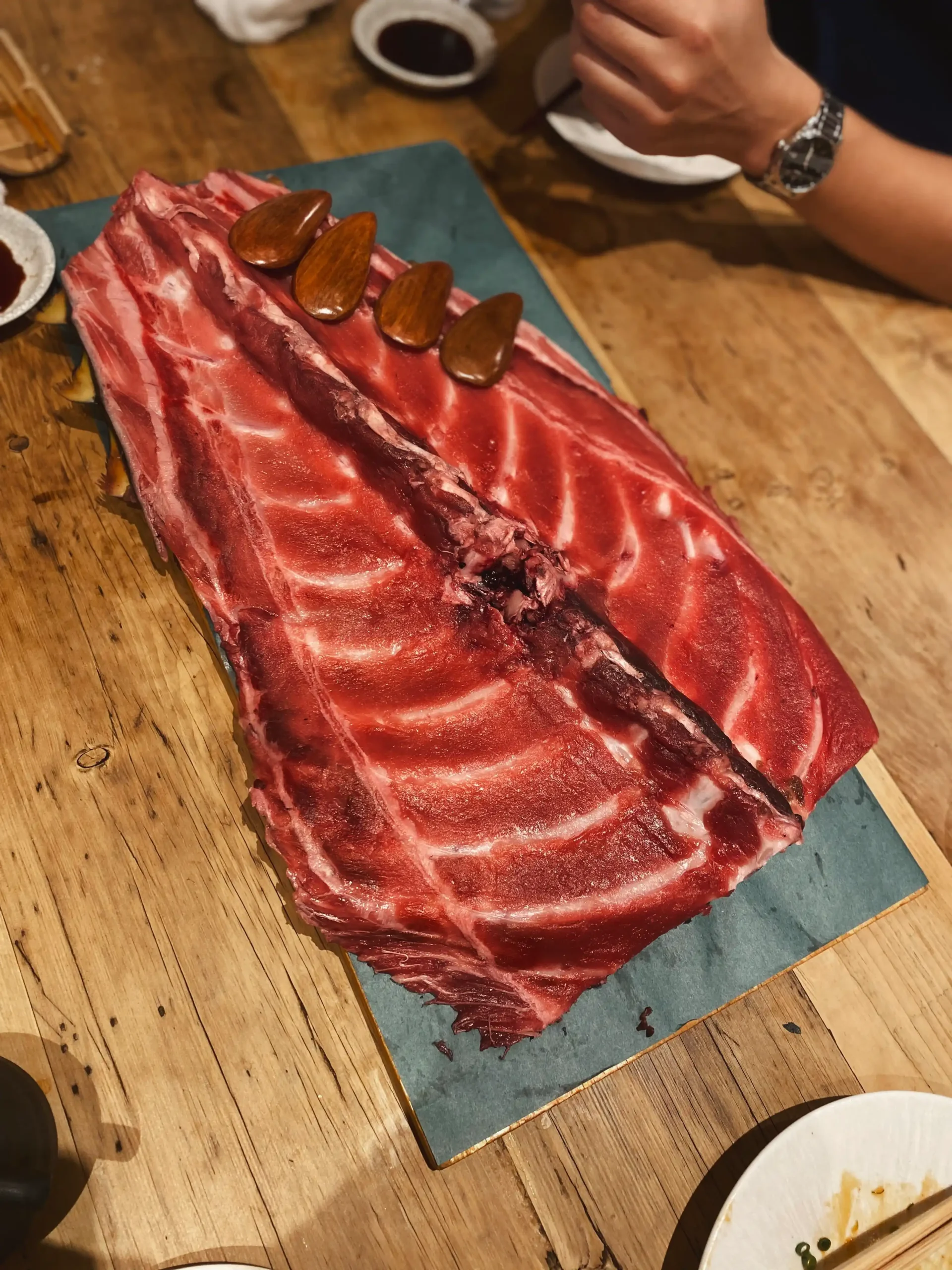
Tuna de Résistance
The pièce de résistance arrived during the fourth course. Laid in front of us was the large backbone of a tuna fish, shared among the table, displayed in all its fatty glory. The server explained that this was called “Nakaochi”: a traditional way of eating maguro, where we scraped the meat off the bones to assemble our own tiny bites of sushi. The fifth course consisted of a bowl of rice and nori to accompany this activity.
It was a truly enjoyable experience and probably the highlight of the entire dinner—not just because of the novelty of having such a large fish carcass in front of us, but because it was incredibly flavorful as well. Our mothers always tell us that meat is tastier when it’s close to the bone, and this certainly proved that theory true. My party of four devoured the entire tuna back, feeling proud of our accomplishment. However, when the waiter returned, he flipped it over to reveal another side to consume. We were already incredibly full, but somehow, we didn’t mind. “Just eat it. It’s the best part of the tuna,” the waiter said. We agreed.
The sixth dish on the tasting menu was a welcome change of pace: simmered tuna accompanied by a deeply flavorful fish broth. While my friends expressed that it wasn’t their favorite dish of the night, I declared it to be in my top two, following the scraped tuna back. Not only did it introduce me to a new way of cooking tuna, but it also opened my mind to an exciting new flavor. The tuna had been simmered for hours with wonderful herbs and Japanese spices, resulting in a sweet, rich broth that I can’t forget to this day.
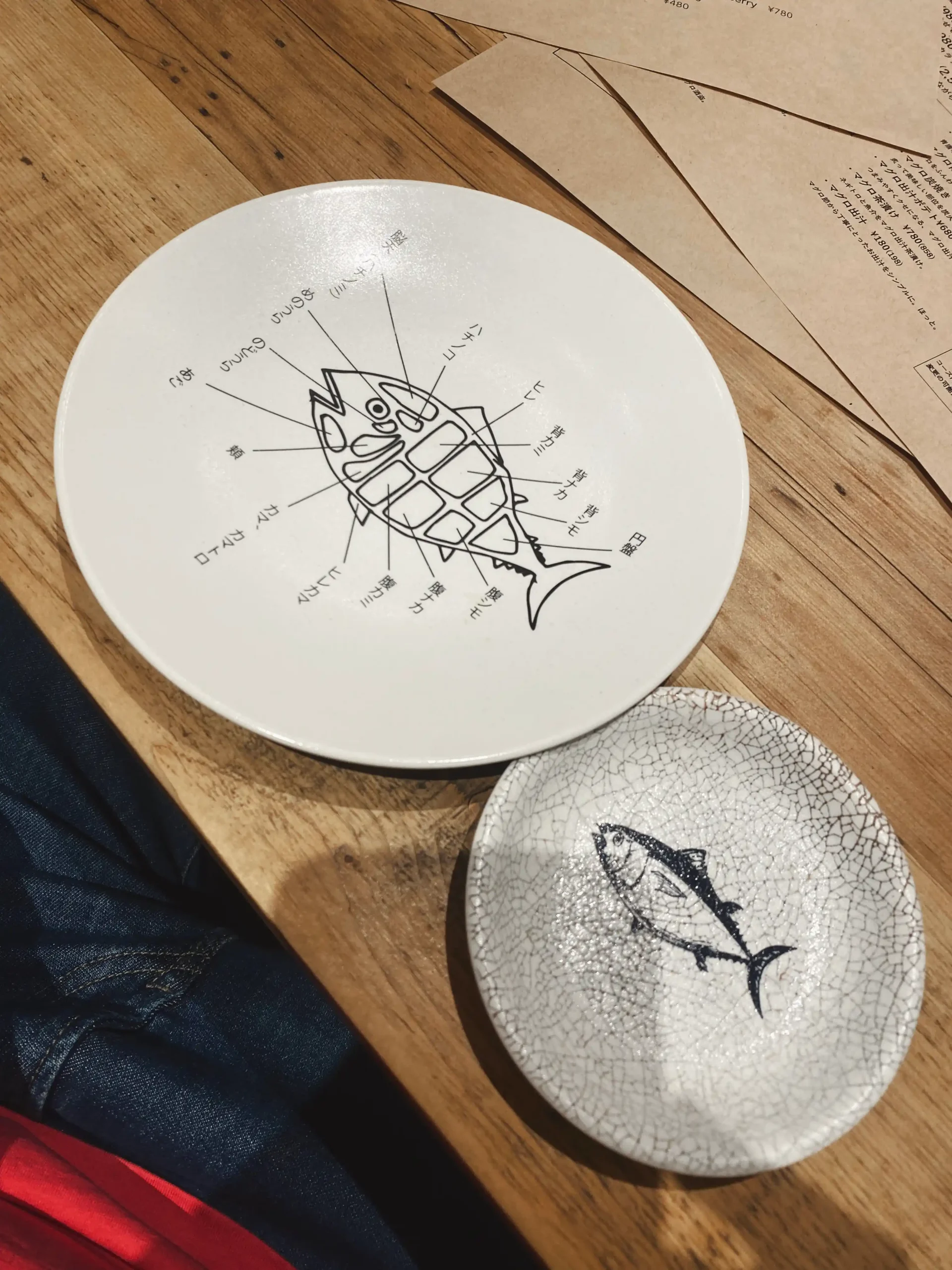
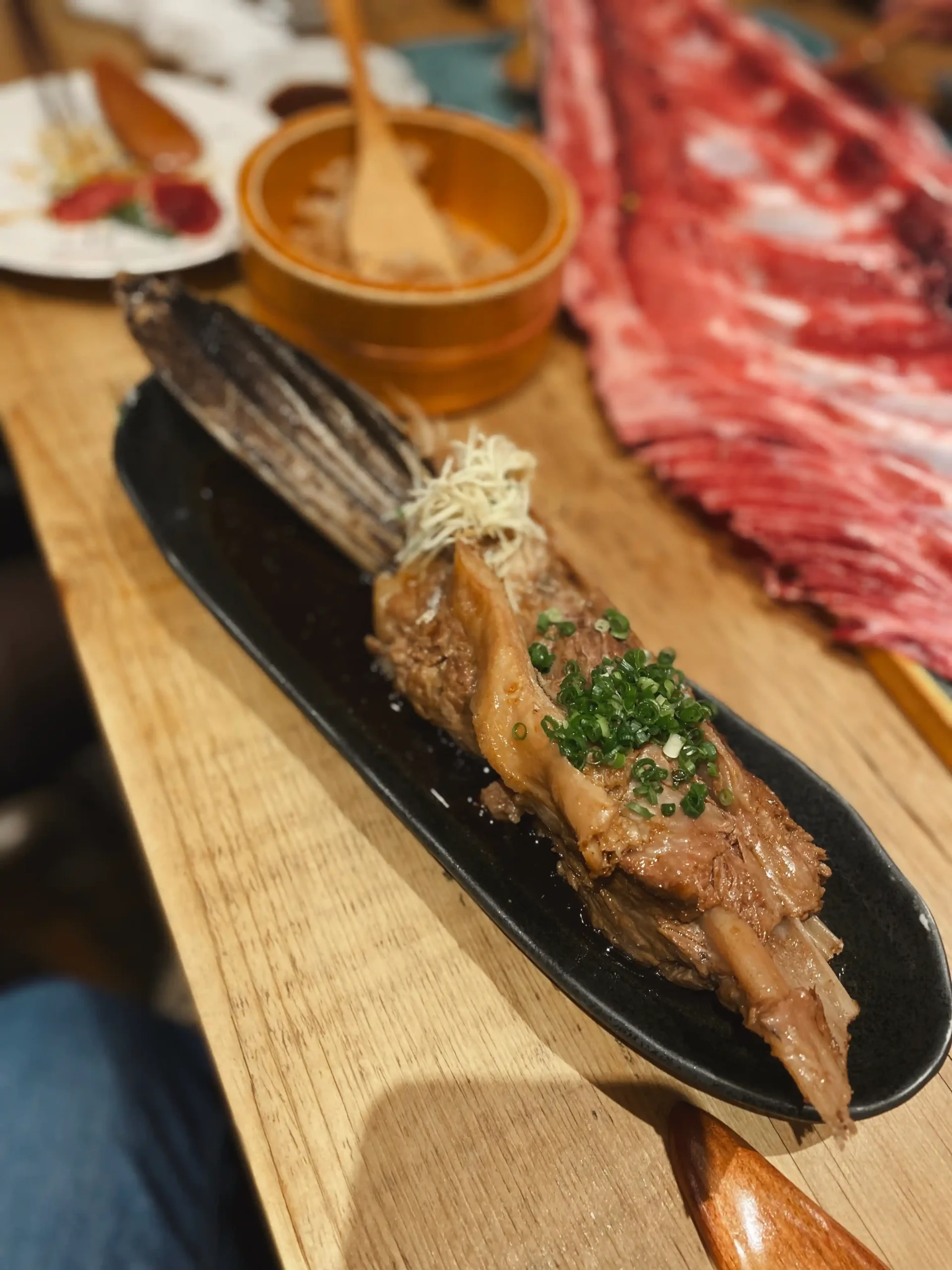
Battle Of The Bulge At Maguro Mart
We finally arrived at our last two courses. We were ready to unfasten the top buttons of our pants, but as foodie warriors, we were determined to make it to the end of the Battle of the Bulge—the stomach bulge, that is. Maguro Mart saw no reason to slow down, even with the penultimate dish, which was as rich as ever. It was a generous bowl they called “Uni-sho,” where fresh sea urchin was mixed with bluefin tuna, resulting in a creamy creation reminiscent of a delicate dessert.
While the sweetness of the previous course would have made the perfect finale, we were served one final dish, in two small bites: a deep-fried oyster and a piece of battered, fried tuna. Both were perfectly cooked and absolutely delicious. Though to be honest, it was a bit much, as we were already deep in a food coma by then. It’s not that we didn’t enjoy every part of the meal—we did—but we all agreed that next time, we’d probably opt for the seven-course menu instead. Eight was one course too many.
But did we regret any of it, even when we were so full we could barely move? Absolutely not. One of the best parts of traveling is discovering something new—and Maguro Mart delivered the full experience. We stepped out of our comfort zones to find it in an unfamiliar corner of Tokyo, tried unconventional tuna dishes we’d never encounter in more mainstream neighborhoods, and shared it all with people we love. That made it even better. And how many diners can say they’ve eaten maguro scraped off an entire tuna backbone? I’m grateful I can.
